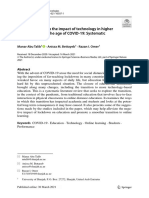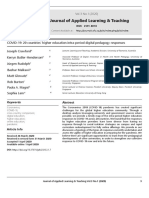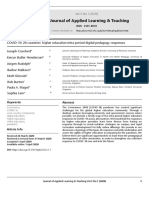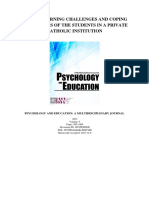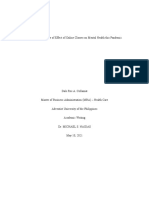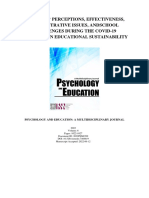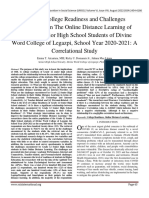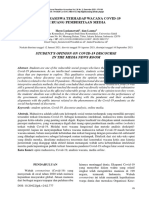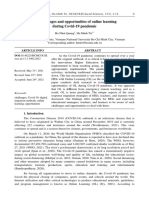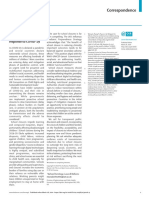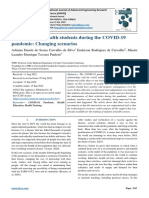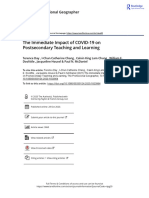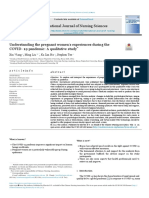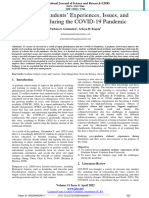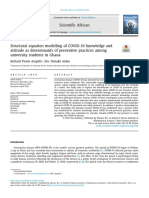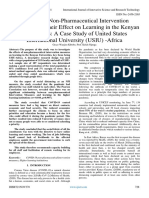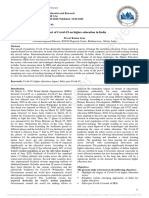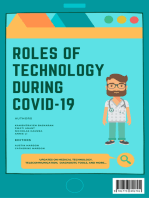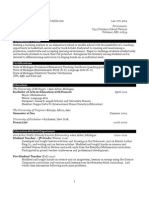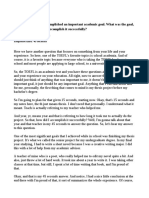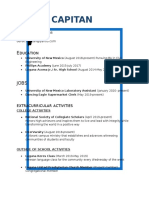Professional Documents
Culture Documents
Challenges and Survival Strategies For Higher Learning Institutions Post Covid - 19
0 ratings0% found this document useful (0 votes)
11 views6 pagesThe higher education sector has experienced
turbulence and crises over the years such as
earthquakes
Original Title
Challenges and Survival Strategies for Higher Learning Institutions Post Covid -19
Copyright
© © All Rights Reserved
Available Formats
PDF, TXT or read online from Scribd
Share this document
Did you find this document useful?
Is this content inappropriate?
Report this DocumentThe higher education sector has experienced
turbulence and crises over the years such as
earthquakes
Copyright:
© All Rights Reserved
Available Formats
Download as PDF, TXT or read online from Scribd
0 ratings0% found this document useful (0 votes)
11 views6 pagesChallenges and Survival Strategies For Higher Learning Institutions Post Covid - 19
The higher education sector has experienced
turbulence and crises over the years such as
earthquakes
Copyright:
© All Rights Reserved
Available Formats
Download as PDF, TXT or read online from Scribd
You are on page 1of 6
Volume 7, Issue 9, September – 2022 International Journal of Innovative Science and Research Technology
ISSN No:-2456-2165
Challenges and Survival Strategies for Higher
Learning Institutions Post Covid -19
Gwebente Mudenda, Dr Burton Mweemba, Professor Edwin Bbenkele, Boyd Longwe, Windu Matoka
ZCAS University, School of Business Lusaka, Zambia
Abstract:- The higher education sector has experienced I. INTRODUCTION
turbulence and crises over the years such as
earthquakes, hurricanes and other catastrophes. Higher The Covid- 19 pandemic has been witnessed in many
learning institutions have responded to these in diverse spheres of life, including management of higher learning
ways. The Covid-19 pandemic unlike other forms of institutions (Bebbington, 2021). The pandemic has brought
crises which oftentimes were region specific in nature about many challenges in many sectors of the economy
was a global crisis. The epidemic in addition to being a across the globe (Tamrat, 2021). Following the disease
global phenomenon came so swiftly and was associated management protocols which were put forward, some
with protocols that instantly required abandonment of organisations closed down while others survived and had to
traditional modes of teaching and learning as it required find avenues for survival in an environment that had
social distancing measures to save lives for tertiary experienced stagnation and turbulence (Tamrat, 2021). It is
institution workers and students. Most educational against this background that this research has been
institutions had to resort to remote or virtual learning commissioned.
modes of teaching and learning. As a result of urgency
with which the pandemic came, there was little room to II. RESEARCH QUESTIONS
reflect on the response strategies or even budget for The purpose of the study is to review scholarly
follow up interventions. The key impacts from the literature onhigher learning institution’s survival strategies
pandemic were that there was sudden shift to online recommended by researchers in response to the pandemic.
modes of delivery across the globe. This brought about The study is intended to answer the following research
mental strain among learners and lecturers who had to questions:
shift to predominantly online modes of engagement with
How did Covid- 19 affect tertiary learning institutions?
minimal or no prior training on use of online teaching
What strategies have been used by higher learning
and learning platforms.
institutions in the post Covid- 19 era to mitigate its
Furthermore, higher learning institutions adverse effects?
experienced reduced incomes especially for institutions
III. METHODOLOGY
that heavily depended on foreign students as enrolments
shrank due to travel bans that were associated with the The study will take a cross sectional review of selected
pandemic. The response mechanisms which succeeded scholarly articles on the subject from materials on the
were those closely tied to institutions that already had subject from April 2020 to June 2022. For purposes of this
online engagement before the pandemic. Major review, the two research questions will be addressedby
challenges encountered by learning institutions had to do consideringa number of studies that were undertaken from
with online delivery support infrastructure, learning different parts of the globe. Some literature assumes a global
platforms, internet access, speed and cost. No universal perspective while others are region specific studies. The
survival strategies emerged except for smooth transiting literature was drawn from Australia, Ethiopia, South Africa,
from face to face interactions to virtual modes of USA and Romania to mention but a few. The researchers
delivery. Stakeholder engagement was identified as a took such a perspective to have a broad understanding of
critical factor by institutional leaders in coming up with impacts the pandemic had on higher learning institutions and
survival strategies, for mitigating the adverse effects of follow up mitigation strategies to withstand the turbulence.
the pandemic.
Insights from the literature would be used for drawing
Keywords:- Covid-19, Crises, Response, Strategies. conclusions on effects of the pandemic and resultant
mitigation strategies.
IJISRT22SEP725 www.ijisrt.com 1190
Volume 7, Issue 9, September – 2022 International Journal of Innovative Science and Research Technology
ISSN No:-2456-2165
A. Overview of the Impact of Covid-19 Pandemic on Higher alternatives (Graham and Donaldson, 2020). As a result,
Education Globally politicians regularly turned to urgent pronouncements to
Global higher education is no stranger to the upheaval reach snap judgments. There was no time for preparing
caused by significant social, political, and economic change, during times of heightened pandemic or high disturbance as
but the magnitude and scope of COVID-19 are it was imperative to act quickly and carefully Global spread
unprecedented in an era when it is both widely accessible as well as the interruption of indigenous procedures from an
and extremely internationalized. Leaders were forced by the unforeseen danger were what made this outbreak what it
COVID-19 epidemic to make crucial choices in the face of was. Therefore, COVID-19 is better described as the
uncertainty, peril, volatility, and time constraints in order to dynamics of disaster whereby instability characterizes the
discover ways to save their people and their businesses. environment. The COVID reaction began to be extensively
known in lines of swift intervention to safeguard lives
Turbulence is ‘a period of inherently uncertain, shifting, (Sharma, 2020). And so was the experience with COVID-
incoherent, changeable, unexpected or unpredictable 19, disasters frequently force leadership to create snap
interactions between occurrences, expectations, and/or judgments rather than lengthy preparations
people, more often than not referred to as the "ground is in whenevercompanies need to switch between ordinary
motion"’ (Garretson, 2021).Due to the turbulence that programming engagement to speedy reaction (Horton,
results, the emergency occasion might already have passed 2020). Disruption encourages academic institutions to
or altered by the period implementable learning occurs. improve business activities, but it also frequently causes
Turbulence, according to Ansell (2017, p. 78) is ‘a condition demand for quick, abrupt change that could show extreme
where events, needs, and assistance interplay and fluctuate volatility (Lemoine, 2020). International universities and
in extremely unstable, irregular, unanticipated, or colleges were under pressure to respond swiftly to these
unforeseen ways.’ Due to their constant variability and lack shifting circumstances in time to prevent incompatibilities
of consistence, unsteady occurrences are also perceived as within their surroundings.
chaotic as they exhibit disarray and uncertainty (Lemoine,
2020). The three things which seem to cause turbulence For organizations, disruption frequently brings shocks,
most frequently are quickness, complication, and crisis which makes planning challenging. A company's ability to
escalation. A crisis is ‘a major risk towards the complexes predict things is a prerequisite for planning. While
or rather the underlying traditions of a community, instability makes it challenging to make predictions,
necessitating the taking of important choices within time planning would frequently perform poorly within those
pressures in extremely unknown conditions’(Garretson, circumstances. Disruption makes it difficult to make split
2021). Potential danger, speed, plus ambiguity constitute second decisions, yet authorities for tertiary education
three crucial characteristics of a crisis, according to (Boin, around the world reacted in a nearly unprecedented show of
2010). When there is a need for an immediate reaction to solidarity by shutting institutions and switching to virtual
events that is unknown and endangers core beliefs or life- learning to keep people safe (students, teachers, and
supporting mechanisms, a crisis has occurred (Zhang, 2018). employees) and their output (client knowledge) (Marshall J.,
Turbulence can also result in unexpected events, instability, 2020). To become more resilient, an institution must learn
quickly changing operating plans, competing priorities, and what to do to transition from its pre-crisis status to a given
unpredictability (Boin and Ansell, 2019). role that is superior (Izumi, 2020). It refers to navigating the
problem with plenty dexterity to deal with difficulties and
Global marketization has engulfed tertiary education, increase reactivity to different experiences. Being a
and the business for universities around the world is worldwide issue, Covid-19 affects nearly majority of the
growing quickly. The development, distribution, and use of planet (Carpenter, 2020).
learning is crucial for the world's colleges and universities.
Because of the turbulence in this chaotic world, knowledge B. Covid - 19 Impact on Australian Public Universities.
and information are held in higher regard and are therefore Carnegie (2021) did a research based on Australian
more globally connected than economic considerations, public universities on effects of covid-19 pandemic. This
which leads to a state of dynamic instability. Nevertheless, research likened to the impacts of Covid-19 to the ‘black
the worldwide higher education industry is generally seen as elephant in the room’. The basis of giving such an approach
a key driver of economic growth. Keeping a distinct identity was that there was a problem in Australian public
and still being adaptable enough even to handle volatility, universities although no one was willing to publicly talk
like the COVID-19 epidemic, is difficult for several about the problem (Ibid). The purpose of the study was to
businesses nowadays (Waller, 2020). Our world is becoming explore the social and financial risks that were associated
more unstable, and the challenges prevent their being with the pandemic. The authors gathered data using media
available and waiting answers. The ability of leadership to reports and annual reports from the thirty-seven public
make decisions amid times of peril, pressure, or ambiguity is universities based in Australia.
demonstrated more by volatility throughout a disaster.
Significant trade-offs are involved during epidemic The challenge to Covid-19 was termed as the black
regulatory changes, like reducing educational engagement elephant in the room because according to legislation, public
that preserve life (Busby, 2020). Unfortunately, due to the universities are not supposed to be profit making institutions
unresolved research and inconsistent data regarding but charitable institutions (Carnegie, 2021). Despite that,
COVID-19, important choices were taken without just like other universities elsewhere, Australian universities
authorities having a complete understanding on available were expected to create and share knowledge for the benefit
IJISRT22SEP725 www.ijisrt.com 1191
Volume 7, Issue 9, September – 2022 International Journal of Innovative Science and Research Technology
ISSN No:-2456-2165
of the masses. To support this ideal, Australian public careful planning to maximise engagement and minimise
universities used to get grants from the government. student fraud in assessments (Lassoued, 2020). In
However, these grants were not adequate to support responding to the epidemic, institutions had to make do with
university operations. It was against such background that the available infrastructure.
the authorities decided to liken the Australian situation as
the elephant in the room as there was a problem which no Migration from face to face to Emergency Remote
one was willing to openly discuss. The grants were Education (ERE) came with challenges. These included four
inadequate but universities were still expected to deliver major dimensions.The first dimension was personal
satisfactorily (Andrew, 2020). rejection and resistance to emergency remote education. The
second aspect had to do with challenges closely related to
Due to inadequate public funding for universities, administering examinations and tests online and being able
there has been commercialisation of public universities to identify student strengths and weaknesses. The third
(Carnegie, 2021). This initiative embraced four dimensions challenge had to do with technical challenges. This had to
of focusing on performance management, adoption of do with weak internet speed, security and data
competitive quasi market methods for recruiting students, confidentiality. The fourth obstacle had to do with financial
increasing dependence on international student fee income, difficulties. To deliver online, it was necessary to have
and intensifying competition for research grant financing capabilities and platforms to communicate remotely. Some
(Ibid). students had challenges procuring computers for use for the
exercise Oliveira (2021). Despite these obstacles,
Foreign student’s income became a significant institutions had to migrate to remote education as a matter of
proportion for universities operating in Australia. In 2018 emergency.
the number of foreign students that were studying in
Australia where 200,000 representing about38% of total D. Education in Emergencies and Lessons from Covid -19
income and by 2019 the number had grown to about In South Africa
330,000accounting for 44% of income and was expected to Landa (2021) undertook a study in South Africa detailing
be growing going forward. The proportion of income lessons which were learnt from Covid-19 as the education
accounted for by foreign students was 38% in 2018 and 44% sector found itself in emergency. They undertook a
in 2019 (Andrew,2020). The global covid-19 pandemic qualitative study which considered strategies which were
came with travel restrictions which had the resultant effect undertaken by two rural institutions of higher learning
of reduced incomes. As if this was not enough, there was a following the lockdown that was declared in South Africa in
strong push to adopt other forms of learning other that face response to the Covid-19 pandemic. The research was
to face interactions. focused on two rural institutions in Eastern Cape
Province.Prior to Covid-19, there were protests over
The key outcomes from the research were revelations accommodation dissatisfaction, institutional management
that institutions were exposed to financial and social risks and student registration exclusion arising from students’
following the pandemic. As a result of Covid-19, the debt. Before the onset of Covid-19, there was already
number of fee-paying foreign students reduced substantially. another disaster of student protests (Ibid, 2021).
The social changes manifested through job losses, mental
strain and health issues, costs of adjustment for learners, The qualitative study of the two institutions in rural
staff and faculty as change to other modes of operation were Eastern Cape aimed at documenting the strategies which
inevitable following the pandemic. Though no specific were employed by the two institutions. Furthermore, there
strategies for survival were expressly recommended, there was need to establish challenges institutions encountered
was a recommendation to strengthen the non-face to face when delivering alternative forms of learning during the
modes of education management and commercialise period of lockdown. Disasters of varying magnitude have
education services. Education leaders were called to rethink been experienced in many parts of the world. Some of such
the traditional ways of managing institutions to survive the disasters include: wars and natural disasters but the Covid-
impact of the pandemic. 19 pandemic was unique and required different interventions
to resolve the associated challenges brought by it(Landa,
C. Covid-19 and Emergent Remote Education in Britain 2021).
Oliveira (2021) did an exploratory study in Britain on the
emergency of remote education experience for tertiary The key findings from the study pointed to the fact that
education learners and educators following the Covid-19 both universities that were used in the study already had
pandemic.The aim of the study was to understand the online presence before the onset of Covid-19. The onset of
educational process, technological tools and personal Covid-19 made institutions to consolidate the remote online
adaptation for students and teachers.Countries have model of learning. However, this sole reliance on remote
experienced disasters such as armed conflicts, hurricanes, education had its own challenges to both learners and
earthquakes and others which affects infrastructure and lecturers. One of the challenges was the battle of using
therefore challenge the conventional forms of learning. technical IT terms anduse of conventional technology
Unlike the above, Covid-19 affected migration and not devices for purposes of teaching without any prior learning
physical infrastructure. The pandemic came so abruptly and about their usage in delivery of learning.The remote
did not prepare institutions for online delivery. Online universities had challenges of internet connectivity and
delivery though a good form of student engagement required access. Furthermore, there were challenges of delivery
IJISRT22SEP725 www.ijisrt.com 1192
Volume 7, Issue 9, September – 2022 International Journal of Innovative Science and Research Technology
ISSN No:-2456-2165
online as students and lectures were not very conversant F. Experiences and Perspectives from Covid-19 on
with the usage of ICT in education. It also came out that Leadership for Higher Education Institutions In
rural institutions have much more prominent challenges of Romania
affording the cost of connectivity in as much as the internet Mutlu (2021)did a study on academic leadership in time
connectivity itself is weak (Landa, 2021). The other of covid-19. The study used a case study on University of
challenges brought out by lectures was the difficulty of Romania to establish experiences for academic leaders in
monitoring students as it was difficult to validate that times of crisis. Covid-19 as a crisis necessitated immediate
students did the work on their own. Assessments were much change and required innovative solutions. Among the
more difficult to administer in terms of exams and tests and outcomes of covid-19 were the associated stress and
being sure that there were no malpractices in the process psychological pressure which came with the epidemic to
(Ibid). students and other educational stakeholders. It was also
characterized with ambiguity and lack of information which
E. Enduring the Impacts of Covid-19 by Higher Education would make educational leaders adequately deal with it.
Institutions in Ethiopia Under the above conditions, there was need to create
The higher education sector has been noted as one of the resilient organization. Necessity for fast learning and wise
sectors that have been adversely affected by the pandemic thinking cannot be overemphasized in times of crisis. It
(Wondwosen, 2021). Mixed methods of data gathering were therefore calls for exceptional and competence to be able to
used whereby a diary documenting key events in Ethiopia make decisions in periods of turmoil as was the case of
was done. The other aspect was an online survey where covid-19 (Mutlu, 2021).
questionnaires were sent out to all members of Ethiopian
Private Technical and Vocational Education and Training In the case of academic leadership, there are many
and Higher Education (Ibid). Much of Ethiopian higher layers from the Vice Chancellor to operatives. All this need
education is dominant by private owners or sole proprietors. proper coordination. There are also various aspects of
As regards to education, the pandemic entailed banning of leadership embracing teaching leadership which is
students and teachers meeting except by online means or concerned with issues of pedagogy; research leadership
other interventions which were not a variance with social focusing on production and sharing of knowledge and
distancing which were imposed following the outbreak of strategy embracing aspects of strategy and setting the vision
Covid-19.The impact of the pandemic was more serious on of the institution (Mutlu, 2021).Multiple models were used
private higher education institutions since they did not get in analysing attributes of effective leaders. According to the
grants from government while the public sector institutions model by (Nathanial P., 2020)effective leadership was
were cushioned by government grants. viewed as having four attributes.The first element was
associated with understanding the nature of crisis as the
In addition to financing and performance challenges, starting point in crisis management. The second aspect
there was also another challenge of shifting to online mode involved scanning through the options for mitigating the
of learning. The transition to virtual mode of delivery had its crisis and making viable recommendations from the options.
own challenges such as technical, social and structural. The third aspect wasconcerned with gaining stakeholder buy
Virtual learning demanded students and lecturers being in through effective communication. Finally, it was
equipped with technical skills and the institutions needed to necessary that the recommended strategies were executed as
have infrastructure which often times was not adequate. mere designing of strategies would not yield any results
Furthermore, acquiring infrastructure and getting good (Mutlu, 2021).
connectivity required huge budgets which many private
learning institutions could not afford. Adjusting from face to The researchers referred to other models of academic
face delivery was especially difficult where internet access, leadership (Koehn, 2020) identified four components of
cost, availability of computers supporting technology effective leaders. These included availing clear roles,
coupled with lack of preparation for the pandemic were at concentrating on learning experience, emotional ability and
play. Responding to the pandemic had its toll on expenses acknowledging fear. All the four components needed to be
yet incomes were receding. Furthermore, institutions were given attention to effectively manage in a crisis (Koehn,
expected to keep lecturers and incur other expenses.The 2020). Citing Schwantes (2020), Mutlu (2021) mentioned
pandemic had a net adverse effect on private sector higher four competences which were needed for leading in times of
learning institutions as the pandemic demanded higher crisis. They included: flexibility, accounting for emotions,
expenses without a complimentary income increase accommodating other opinions and gaining stakeholder
(Wondwosen, 2021). engagement (Mutlu, 2021).Dimensions suggested by
(Dirani, 2020) were that leadership should be the sense
maker in a flux. After that, it was necessary that leaders play
the role of technology enhancers. In crisis times, there are
emotional issues which arise and therefore academic
leadership should take centre stage in managing emotions.
As all this is happening there is need for leadership to foster
employee well-being and maintain innovative
communication to ensure that there is collectivism in
managing the crisis (Dirami, 2020; Mutlu, 2021).
IJISRT22SEP725 www.ijisrt.com 1193
Volume 7, Issue 9, September – 2022 International Journal of Innovative Science and Research Technology
ISSN No:-2456-2165
In the case of Covid-19, the researchers concluded that REFERENCES
shared leadership was more appropriate in managing the
disruption that it brought. It was inevitable to disrupt [1.] Andrew J., B. M. (2020). Australia' s Covid-19 public
conventional organizational norms and explore other budgeting response: the straight jacket of
innovative opportunities by substituting normal face to face neoliberalism. Journal of Public Budgeting,
interactions to build organizational resilience by being Accounting and Financial Management 32 (5), 759-
adaptive (Mutlu, 2021). 770.
[2.] Ansell, C. &. (2019). Taming deep uncertainty : The
IV. CONCLUSIONS potential of pragmatist principles for understanding
and improving strategic crisis management.
As much as disruptions have been experienced in Administration and Society, 51 (7), 1079-1112.
higher education, Covid- 19 was much more of an [3.] Ansell, C. (2017). Turbulence, Adaptation, and
emergency. It never gave leaders for educational institutions Change in Governance in turbulent times . London:
an opportunity to plan for response mechanisms. The Oxford University Press.
literature has brought out mixed conclusions that tertiary [4.] Bebbington, W. (2021). Leadership strategies for
learning institutions in remote areas had bigger challenges of higher education sector in a flux. Studies in Higher
adapting as online and remote learning which became the Education Volume 46 Issue1, 158-165.
most prominent mode of education delivery was hampered [5.] Boin, A. &. (2010). Organising for effective
by inadequate or even non-availability of platforms for emergency management: Lessons from research.
delivering online learning. Poor ICT infrastructure, Australian Journal of Public Administration 69 (4),
unreliable internet connectivity and cost of internet bundles 357-371.
to support connectivity also emerged as a challenge [6.] Busby, J. (2020). Understanding the anemic global
especially for students in remote areas where connectivity response to Covid-19. Journal of Health Politics,
was low. This was particularly the case for students in Policy and Law 45 (6), 1013-1021.
Eastern Cape Province of South Africa. [7.] Carpenter, R. S. (2020). The implications of covid 19
on educators, students, curricula and faculty
Revelations from literature further indicated that development. The Journal of Faculty Development 34
responding to the pandemic also brought in stress on (2), 9-14.
students andlecturers who had to learn to interact purely [8.] Christopher J Garretson, T. J. (2021). The Impact of
online. Some of the education delivery platforms had Turbulence On Global Higher Education During a
technical terms and it was not automatic and easy for users Pandemic. International Journal of Innovative
to operate them. The pandemic left no room for people to Research and Advanced Studies Volume 8 Issue 1,
learn about online delivery software as it came so abruptly 30-35.
and institutions were compelled to adhere to the disease [9.] D., P. L. (2020). Australian Universities in a
prevention protocols which were imposed at global and pandemic world: transforming a broken business
national levels. The migration from face to face interactions model? . Journal of Accounting and Organisational
in tertiary education institutions to virtual dimensions of Change 16 (4), 541-548.
engagement had possibilities for compromising integrity of [10.] Dirani, K. M. (2020). Leadership competences and
assessments through academic fraud. the essential role of human resource development in
Literature has revealed that success for strategies for times of crisis: a response to Covid-19 pandemic.
coping with the pandemic depended on availabilityof ICT Human Resource Development International 23, 380-
infrastructure, good internet access and positive attitudes 394.
from educational leaders, students and faculty. It emerged [11.] Gabriella Oliveira, A. T. (2021). An exploratory
that institutional leaders that were innovative and not study on the emergency remote education experience
traditional stood higher chances of survival during and after of higher education students and teachers during the
the pandemic. This was particularly so as pandemic Covid-19 pandemic. British Journal of Education
translated in loss of clients and resulted in reduced incomes. Technology, 1357-1377.
Private higher learning institutions felt the bigger adverse [12.] Garry D. Carnegie, A. M. (2021). Taming the black
effect from the pandemic than public institutions as they had elephant in the house: assessing and managing the
no grants from their respective governments. There was impacts of Covid -19 on public universities in
need by educational institution leaders to take on board Australia. Emerald Insights.
multiple stakeholder needs in bringing about successful [13.] Horton, R. (2020). The Covid-19 catastrophe: What's
adaption in managing the after effects of the pandemic. gone wrong and how to stop it from happening again.
Cambridge: Polity Press.
[14.] Izumi, T. S. (2020). Managing and responding to
pandemics in higher educational institutions: Initial
learning from Covid-19. International Journal of
Disaster Resilience in the Built Environment.
[15.] Koehn, N. F. (2020). Real Leaders are forged in
CRISIS. Harvard Business Review.
[16.] Lassoued, Z. A. (2020). An exploratory study of
obstacles for achieving quality in distance learning
IJISRT22SEP725 www.ijisrt.com 1194
Volume 7, Issue 9, September – 2022 International Journal of Innovative Science and Research Technology
ISSN No:-2456-2165
during the Covid-19 pandemic. Education Sciences
10 (9), 232.
[17.] Lemoine, P. a. (2020). Planning for Higher Education
Institutions: Chaos and the Covid-19 pandemic.
Educational Planning (Centennial Edition) 27 (3),
43-57.
[18.] Marshall J., R. D. (2020). Crisis leadership: A critical
examination of educational leadership in higher
education in the midst of Covid-19 pandemic. ISEA
48 (3), 30-37.
[19.] Mutlu, D. D. (2021). Academic leadership in the time
of Covid-19- Experiences and perspectives. Open
Access.
[20.] Nathanial P., a. v. (2020). Crisis management:
Framework and Principles with Applications to
Covid-19. INSEAD Working paper
No.2020/17/FIN/TOM.
[21.] Nhlanhla Landa, S. Z. (2021). Education in
Emergencies: Lessons from Covid-19 in South
Africa. International Review of Education Volume 67,
167-183.
[22.] Tamrat. (2021). Enduring impacts of Covid 19:
Experiences of private higher education sector in
Ethiopia. Studies in Higher Education Volume 46
Issue 1, 59- 74.
[23.] Waller, R. E. (2020). Global Higher Education:
Complexity and Uncertainty . International
Education and Research Journal 6 (4), 57-57.
[24.] Wondwosen, T. (2021). Enduring the impacts of
Covid- 19: experiences of higher education sector in
Ethiopia. Studies in Higher Education Volume 46
Issue 1, 59-74.
[25.] Zhang, F. W. (2018). Public organisation to extreme
events: Mediating role of risk perception. Journal of
Public Administration Research and Theory 28 (3),
371-387.
IJISRT22SEP725 www.ijisrt.com 1195
You might also like
- LIreature Review Entrepreneurial EducationDocument18 pagesLIreature Review Entrepreneurial EducationRohit ChandNo ratings yet
- Pertegal-Felices Et Al. (2022)Document12 pagesPertegal-Felices Et Al. (2022)Nicolas212No ratings yet
- AbuTalib2021 Article AnalyticalStudyOnTheImpactOfTeDocument28 pagesAbuTalib2021 Article AnalyticalStudyOnTheImpactOfTenanthini kanasanNo ratings yet
- COVID-19: Impact on Education and BeyondFrom EverandCOVID-19: Impact on Education and BeyondNivedita Das KunduRating: 2 out of 5 stars2/5 (5)
- LTM 05Document8 pagesLTM 05SolNo ratings yet
- The Effect of Covid-19 Pandemic On Higher Education: Students' PerspectiveDocument17 pagesThe Effect of Covid-19 Pandemic On Higher Education: Students' PerspectiveIJELS Research JournalNo ratings yet
- Published May 22 2020 Erick T. Baloran Knowledge Attitudes Anxiety and Coping Strategies of Students During COVID 19 PandemicDocument10 pagesPublished May 22 2020 Erick T. Baloran Knowledge Attitudes Anxiety and Coping Strategies of Students During COVID 19 PandemicReign SeptemberNo ratings yet
- Paper 2003Document5 pagesPaper 2003Rhyson 2009No ratings yet
- Impact of Covid-19 Pandemic On Higher EducationDocument10 pagesImpact of Covid-19 Pandemic On Higher EducationDiego Cano100% (2)
- Challenges and Opportunities For Higher Education Amid The COVID-19 Pandemic: The Philippine ContextDocument6 pagesChallenges and Opportunities For Higher Education Amid The COVID-19 Pandemic: The Philippine ContextMae Anne Yabut Roque-CunananNo ratings yet
- Digital Innovation in Times of Crisis How Mashups ImproveDocument18 pagesDigital Innovation in Times of Crisis How Mashups ImproveJang JubNo ratings yet
- Manzanedo RD, Manning PDocument4 pagesManzanedo RD, Manning PmaiconNo ratings yet
- Impact of Covid 19Document3 pagesImpact of Covid 19John Paul DianNo ratings yet
- A Multi Sectoral Assessment of The Impacts of Covid 19 Pandemic Outbreak On Organisational Functionality in NigeriaDocument13 pagesA Multi Sectoral Assessment of The Impacts of Covid 19 Pandemic Outbreak On Organisational Functionality in NigeriaEditor IJTSRDNo ratings yet
- Media Exposure, Attitude, Anxiety and Practices Among University Students During The COVID-19 PandemicDocument12 pagesMedia Exposure, Attitude, Anxiety and Practices Among University Students During The COVID-19 PandemicIJPHSNo ratings yet
- Knowledge, Attitudes, Anxiety, and Coping Strategies of Students During COVID-19 PandemicDocument9 pagesKnowledge, Attitudes, Anxiety, and Coping Strategies of Students During COVID-19 PandemicAindre AmeliaNo ratings yet
- Journal of Applied LearningDocument20 pagesJournal of Applied LearningJose Luis Treviño GonzalezNo ratings yet
- Journal of Applied LearningDocument20 pagesJournal of Applied LearningJose Luis Treviño GonzalezNo ratings yet
- Online Learning Challenges and Coping Mechanisms of The Students in A Private Catholic InstitutionDocument16 pagesOnline Learning Challenges and Coping Mechanisms of The Students in A Private Catholic InstitutionPsychology and Education: A Multidisciplinary JournalNo ratings yet
- A Literature Review of Effect of Online Classes On Mental Health This PandemicDocument14 pagesA Literature Review of Effect of Online Classes On Mental Health This PandemicDale Ros Collamat100% (1)
- Teacher's Perceptions, Effectiveness, Administrative Issues, and School Challenges During The COVID-19 Epidemic: An Educational SustainabilityDocument7 pagesTeacher's Perceptions, Effectiveness, Administrative Issues, and School Challenges During The COVID-19 Epidemic: An Educational SustainabilityPsychology and Education: A Multidisciplinary JournalNo ratings yet
- How Covid-19 Affected The Education SectorDocument5 pagesHow Covid-19 Affected The Education SectorCarlos kengaNo ratings yet
- 63-70Document8 pages63-70silvacastilloangelieNo ratings yet
- RMDocument3 pagesRMGOKAVARAPU SRIKAR 2127112No ratings yet
- The Future of Business Education A Commentary in The - 2020 - Journal of BusineDocument5 pagesThe Future of Business Education A Commentary in The - 2020 - Journal of BusineseraphNo ratings yet
- Dealing With Disruption Rethinking Recovery Policy Responses To The COVID 19 Pandemic in Higher EducationDocument23 pagesDealing With Disruption Rethinking Recovery Policy Responses To The COVID 19 Pandemic in Higher EducationGabriel Rufo dela CruzNo ratings yet
- Covid19 - Youth Note12Document12 pagesCovid19 - Youth Note12Syed Shafqat ShahNo ratings yet
- Admin,+Journal+Manager,+ (6) +launa+ (175 190)Document16 pagesAdmin,+Journal+Manager,+ (6) +launa+ (175 190)Elliza RomadonaNo ratings yet
- Challenges and Opportunities of Online Learning During CovidDocument12 pagesChallenges and Opportunities of Online Learning During CovidEntertainment E21No ratings yet
- Correspondence: Considering Inequalities in The School Closure Response To COVID-19Document1 pageCorrespondence: Considering Inequalities in The School Closure Response To COVID-19JamesNo ratings yet
- The COVID-19 Pandemic Through The Lens of Education in The Philippines: The New NormalDocument5 pagesThe COVID-19 Pandemic Through The Lens of Education in The Philippines: The New NormalANON12890No ratings yet
- A Literature Review of E-Learning and E-Teaching in The Era of Covid-19 PandemicDocument10 pagesA Literature Review of E-Learning and E-Teaching in The Era of Covid-19 PandemicInternational Journal of Innovative Science and Research TechnologyNo ratings yet
- The Covid-19 Pandemic through Online learning and Lens of education in the Philippines A New NormalDocument12 pagesThe Covid-19 Pandemic through Online learning and Lens of education in the Philippines A New NormalKazuya KinoshitaNo ratings yet
- Reference TableDocument3 pagesReference TableDarbie ParaisoNo ratings yet
- Workplace Safety in Higher Education Institutions During Covid-19 Epidemic: Insights From A Developing CountryDocument6 pagesWorkplace Safety in Higher Education Institutions During Covid-19 Epidemic: Insights From A Developing CountryFadi ShahrouryNo ratings yet
- The Training of Health Students During The COVID-19 Pandemic: Changing ScenariosDocument3 pagesThe Training of Health Students During The COVID-19 Pandemic: Changing ScenariosIJAERS JOURNALNo ratings yet
- International Journal of Information Management: Opinion PaperDocument7 pagesInternational Journal of Information Management: Opinion PaperNanoNo ratings yet
- The Immediate Impact of COVID 19 On Postsecondary Teaching and LearningDocument14 pagesThe Immediate Impact of COVID 19 On Postsecondary Teaching and LearningDzaky DestiawanNo ratings yet
- The Review of Related LiteratureDocument6 pagesThe Review of Related LiteratureIsellah EllenNo ratings yet
- New Covid FormatDocument30 pagesNew Covid Formatasmahdental1No ratings yet
- Covid 19 Pandemic and Online Learning The Challenges and OpportunitiesDocument14 pagesCovid 19 Pandemic and Online Learning The Challenges and OpportunitiesSyed Shafqat Shah67% (3)
- Ubi20402 Draft Academic Essay Outline AssessmentDocument4 pagesUbi20402 Draft Academic Essay Outline AssessmentIda Sofya Shuhada Binti Ab.Rashid G20A0256No ratings yet
- 1 s2.0 S2352013222000382 MainDocument11 pages1 s2.0 S2352013222000382 MainMiskawatiNo ratings yet
- SSRN-id4096431Document6 pagesSSRN-id4096431belindaespanoNo ratings yet
- Philippines' new normal education amid COVIDDocument2 pagesPhilippines' new normal education amid COVIDJhun BalaneNo ratings yet
- The New Normal Educati On: I. ContentDocument13 pagesThe New Normal Educati On: I. ContentVibar, Danica V.No ratings yet
- Challenges To Online Medical Education During The COVID-19 PandemicDocument11 pagesChallenges To Online Medical Education During The COVID-19 PandemicZeeshan KhanNo ratings yet
- ABEL Critical Health Literacy in Pandemics: The Special Case of COVID-19Document9 pagesABEL Critical Health Literacy in Pandemics: The Special Case of COVID-19kelseyNo ratings yet
- Impact of Pandemic On STEM (: Science, Technology, Engineering and Mathematics)Document9 pagesImpact of Pandemic On STEM (: Science, Technology, Engineering and Mathematics)Charles Jandrei PereyraNo ratings yet
- Organized By:: Online Essay CompetitionDocument4 pagesOrganized By:: Online Essay CompetitionSanjib BaglariNo ratings yet
- StructuralDocument10 pagesStructuralnikko.emping.20No ratings yet
- COVID-19 Non-Pharmaceutical Intervention Measures and Their Effect On Learning in The Kenyan Universities A Case Study of United States International University (USIU) - AfricaDocument9 pagesCOVID-19 Non-Pharmaceutical Intervention Measures and Their Effect On Learning in The Kenyan Universities A Case Study of United States International University (USIU) - AfricaInternational Journal of Innovative Science and Research TechnologyNo ratings yet
- Coping With Stress and Burnout Assosiated With OnlineDocument7 pagesCoping With Stress and Burnout Assosiated With OnlineGames KuNo ratings yet
- Interprofessional Education During The COVID-19 Pandemic: Finding The Good in A Bad SituationDocument15 pagesInterprofessional Education During The COVID-19 Pandemic: Finding The Good in A Bad Situationruby susmawatiNo ratings yet
- The New Normal of Education in the Philippines During COVID-19Document3 pagesThe New Normal of Education in the Philippines During COVID-19Lovely GrospeNo ratings yet
- The Role of Science Education in Secondary Schools in Curbing Covid 19 PandemicDocument6 pagesThe Role of Science Education in Secondary Schools in Curbing Covid 19 PandemicEditor IJTSRDNo ratings yet
- Preprint Not Peer Reviewed: Impact of Covid-19 On Higher Education in IndiaDocument5 pagesPreprint Not Peer Reviewed: Impact of Covid-19 On Higher Education in IndiaAnirban Datta Roy.No ratings yet
- Group 2 - Up-Fa1-Stem11-19 - Chapter IiDocument7 pagesGroup 2 - Up-Fa1-Stem11-19 - Chapter IijamesrusselNo ratings yet
- Compact and Wearable Ventilator System for Enhanced Patient CareDocument4 pagesCompact and Wearable Ventilator System for Enhanced Patient CareInternational Journal of Innovative Science and Research TechnologyNo ratings yet
- Insights into Nipah Virus: A Review of Epidemiology, Pathogenesis, and Therapeutic AdvancesDocument8 pagesInsights into Nipah Virus: A Review of Epidemiology, Pathogenesis, and Therapeutic AdvancesInternational Journal of Innovative Science and Research TechnologyNo ratings yet
- Implications of Adnexal Invasions in Primary Extramammary Paget’s Disease: A Systematic ReviewDocument6 pagesImplications of Adnexal Invasions in Primary Extramammary Paget’s Disease: A Systematic ReviewInternational Journal of Innovative Science and Research TechnologyNo ratings yet
- Smart Cities: Boosting Economic Growth through Innovation and EfficiencyDocument19 pagesSmart Cities: Boosting Economic Growth through Innovation and EfficiencyInternational Journal of Innovative Science and Research TechnologyNo ratings yet
- Air Quality Index Prediction using Bi-LSTMDocument8 pagesAir Quality Index Prediction using Bi-LSTMInternational Journal of Innovative Science and Research TechnologyNo ratings yet
- An Analysis on Mental Health Issues among IndividualsDocument6 pagesAn Analysis on Mental Health Issues among IndividualsInternational Journal of Innovative Science and Research TechnologyNo ratings yet
- The Making of Object Recognition Eyeglasses for the Visually Impaired using Image AIDocument6 pagesThe Making of Object Recognition Eyeglasses for the Visually Impaired using Image AIInternational Journal of Innovative Science and Research TechnologyNo ratings yet
- Harnessing Open Innovation for Translating Global Languages into Indian LanuagesDocument7 pagesHarnessing Open Innovation for Translating Global Languages into Indian LanuagesInternational Journal of Innovative Science and Research TechnologyNo ratings yet
- Parkinson’s Detection Using Voice Features and Spiral DrawingsDocument5 pagesParkinson’s Detection Using Voice Features and Spiral DrawingsInternational Journal of Innovative Science and Research TechnologyNo ratings yet
- Dense Wavelength Division Multiplexing (DWDM) in IT Networks: A Leap Beyond Synchronous Digital Hierarchy (SDH)Document2 pagesDense Wavelength Division Multiplexing (DWDM) in IT Networks: A Leap Beyond Synchronous Digital Hierarchy (SDH)International Journal of Innovative Science and Research TechnologyNo ratings yet
- Investigating Factors Influencing Employee Absenteeism: A Case Study of Secondary Schools in MuscatDocument16 pagesInvestigating Factors Influencing Employee Absenteeism: A Case Study of Secondary Schools in MuscatInternational Journal of Innovative Science and Research TechnologyNo ratings yet
- Exploring the Molecular Docking Interactions between the Polyherbal Formulation Ibadhychooranam and Human Aldose Reductase Enzyme as a Novel Approach for Investigating its Potential Efficacy in Management of CataractDocument7 pagesExploring the Molecular Docking Interactions between the Polyherbal Formulation Ibadhychooranam and Human Aldose Reductase Enzyme as a Novel Approach for Investigating its Potential Efficacy in Management of CataractInternational Journal of Innovative Science and Research TechnologyNo ratings yet
- Comparatively Design and Analyze Elevated Rectangular Water Reservoir with and without Bracing for Different Stagging HeightDocument4 pagesComparatively Design and Analyze Elevated Rectangular Water Reservoir with and without Bracing for Different Stagging HeightInternational Journal of Innovative Science and Research TechnologyNo ratings yet
- The Relationship between Teacher Reflective Practice and Students Engagement in the Public Elementary SchoolDocument31 pagesThe Relationship between Teacher Reflective Practice and Students Engagement in the Public Elementary SchoolInternational Journal of Innovative Science and Research TechnologyNo ratings yet
- Diabetic Retinopathy Stage Detection Using CNN and Inception V3Document9 pagesDiabetic Retinopathy Stage Detection Using CNN and Inception V3International Journal of Innovative Science and Research TechnologyNo ratings yet
- The Utilization of Date Palm (Phoenix dactylifera) Leaf Fiber as a Main Component in Making an Improvised Water FilterDocument11 pagesThe Utilization of Date Palm (Phoenix dactylifera) Leaf Fiber as a Main Component in Making an Improvised Water FilterInternational Journal of Innovative Science and Research TechnologyNo ratings yet
- Advancing Healthcare Predictions: Harnessing Machine Learning for Accurate Health Index PrognosisDocument8 pagesAdvancing Healthcare Predictions: Harnessing Machine Learning for Accurate Health Index PrognosisInternational Journal of Innovative Science and Research TechnologyNo ratings yet
- Auto Encoder Driven Hybrid Pipelines for Image Deblurring using NAFNETDocument6 pagesAuto Encoder Driven Hybrid Pipelines for Image Deblurring using NAFNETInternational Journal of Innovative Science and Research TechnologyNo ratings yet
- Formulation and Evaluation of Poly Herbal Body ScrubDocument6 pagesFormulation and Evaluation of Poly Herbal Body ScrubInternational Journal of Innovative Science and Research TechnologyNo ratings yet
- Electro-Optics Properties of Intact Cocoa Beans based on Near Infrared TechnologyDocument7 pagesElectro-Optics Properties of Intact Cocoa Beans based on Near Infrared TechnologyInternational Journal of Innovative Science and Research TechnologyNo ratings yet
- Terracing as an Old-Style Scheme of Soil Water Preservation in Djingliya-Mandara Mountains- CameroonDocument14 pagesTerracing as an Old-Style Scheme of Soil Water Preservation in Djingliya-Mandara Mountains- CameroonInternational Journal of Innovative Science and Research TechnologyNo ratings yet
- Explorning the Role of Machine Learning in Enhancing Cloud SecurityDocument5 pagesExplorning the Role of Machine Learning in Enhancing Cloud SecurityInternational Journal of Innovative Science and Research TechnologyNo ratings yet
- The Impact of Digital Marketing Dimensions on Customer SatisfactionDocument6 pagesThe Impact of Digital Marketing Dimensions on Customer SatisfactionInternational Journal of Innovative Science and Research TechnologyNo ratings yet
- Navigating Digitalization: AHP Insights for SMEs' Strategic TransformationDocument11 pagesNavigating Digitalization: AHP Insights for SMEs' Strategic TransformationInternational Journal of Innovative Science and Research Technology100% (1)
- A Survey of the Plastic Waste used in Paving BlocksDocument4 pagesA Survey of the Plastic Waste used in Paving BlocksInternational Journal of Innovative Science and Research TechnologyNo ratings yet
- Design, Development and Evaluation of Methi-Shikakai Herbal ShampooDocument8 pagesDesign, Development and Evaluation of Methi-Shikakai Herbal ShampooInternational Journal of Innovative Science and Research Technology100% (3)
- A Review: Pink Eye Outbreak in IndiaDocument3 pagesA Review: Pink Eye Outbreak in IndiaInternational Journal of Innovative Science and Research TechnologyNo ratings yet
- Cyberbullying: Legal and Ethical Implications, Challenges and Opportunities for Policy DevelopmentDocument7 pagesCyberbullying: Legal and Ethical Implications, Challenges and Opportunities for Policy DevelopmentInternational Journal of Innovative Science and Research TechnologyNo ratings yet
- Hepatic Portovenous Gas in a Young MaleDocument2 pagesHepatic Portovenous Gas in a Young MaleInternational Journal of Innovative Science and Research TechnologyNo ratings yet
- Automatic Power Factor ControllerDocument4 pagesAutomatic Power Factor ControllerInternational Journal of Innovative Science and Research TechnologyNo ratings yet
- Physics Astronomy PDFDocument22 pagesPhysics Astronomy PDFAbhik SarkarNo ratings yet
- Program Book ICST FinalDocument477 pagesProgram Book ICST FinalBomBomNo ratings yet
- JKUAT Admission Letter Thu-Sep-2021Document2 pagesJKUAT Admission Letter Thu-Sep-2021Abdul WahabNo ratings yet
- NM State University Grant Proposals and ExamplesDocument48 pagesNM State University Grant Proposals and ExamplesJessica Nicole GardinerNo ratings yet
- Social Change and EducationDocument15 pagesSocial Change and EducationOniwura Bolarinwa Olapade100% (2)
- Mamoon's Credibility InterviewDocument5 pagesMamoon's Credibility InterviewLiaison PakistanNo ratings yet
- Information & Digital Literacy For University Success: The University of Sydney Centre For English TeachingDocument4 pagesInformation & Digital Literacy For University Success: The University of Sydney Centre For English TeachingNguyen Thi Thu Hien (K16 HCM)No ratings yet
- Course Handbook GGD 2020-2021Document46 pagesCourse Handbook GGD 2020-2021ZannyNo ratings yet
- Resume Rachel CohenDocument2 pagesResume Rachel Cohenrcohen425No ratings yet
- Gaurika SOP LLM EuropeDocument3 pagesGaurika SOP LLM EuropeAdithyaSirikonda100% (2)
- TOEFL Speaking MagooshDocument79 pagesTOEFL Speaking MagooshEmmanuel Zamora Manuelini ZamoriniNo ratings yet
- Julian Ratcliffe CVDocument2 pagesJulian Ratcliffe CVthebusstopworldNo ratings yet
- NSOUDocument16 pagesNSOUamitjanu_904802No ratings yet
- Université Paris Nanterre Academic Programmes OverviewDocument2 pagesUniversité Paris Nanterre Academic Programmes OverviewVivi HathorNo ratings yet
- Interview Questions For ScholarshipDocument12 pagesInterview Questions For ScholarshipAbesamis RanmaNo ratings yet
- Goals for PhD in Game-based Learning at ITU CopenhagenDocument2 pagesGoals for PhD in Game-based Learning at ITU Copenhagenhamidreza TalebiNo ratings yet
- Motivation Letter Public Administration MasterDocument2 pagesMotivation Letter Public Administration MasterNasiibuu TolaaNo ratings yet
- DISAPPEARING DESTINATIONS: Climate Change and Future Challenges For Coastal TourismDocument296 pagesDISAPPEARING DESTINATIONS: Climate Change and Future Challenges For Coastal TourismShagai Mgl100% (1)
- Donald (Deirdre) N. McCloskey - If You're So Smart - The Narrative of Economic Expertise-The University of Chicago Press (1990) PDFDocument191 pagesDonald (Deirdre) N. McCloskey - If You're So Smart - The Narrative of Economic Expertise-The University of Chicago Press (1990) PDFLuis Angel Velastegui-MartinezNo ratings yet
- Marketing PlanDocument35 pagesMarketing PlanWensen ChuNo ratings yet
- Derek Capitans ResumeDocument4 pagesDerek Capitans Resumeapi-512160668No ratings yet
- Scheme For Promotion of Academic and Research Collaboration: Website: HTTP://WWW - Sparc.iitkgp - Ac.inDocument15 pagesScheme For Promotion of Academic and Research Collaboration: Website: HTTP://WWW - Sparc.iitkgp - Ac.inMayank NautiyalNo ratings yet
- Tributes To Edwin BlackDocument15 pagesTributes To Edwin BlackSarah SpringNo ratings yet
- National Scholars Program 2005 Annual Report: A Growing Tradition of ExcellenceDocument24 pagesNational Scholars Program 2005 Annual Report: A Growing Tradition of ExcellencejamwilljamwillNo ratings yet
- JLL Uk Research Student Housing Report 2019 PDFDocument20 pagesJLL Uk Research Student Housing Report 2019 PDFNatthakitNo ratings yet
- Emory University - Goizueta Business School Start Here. Go AnywhereDocument26 pagesEmory University - Goizueta Business School Start Here. Go AnywhereOmarAndréCastilloGarcíaNo ratings yet
- Inclusivity in Research PHD ScholarshipDocument5 pagesInclusivity in Research PHD ScholarshipThắng NguyễnNo ratings yet
- Ellinwood 1945 Ars MusicaDocument11 pagesEllinwood 1945 Ars MusicaAlfredo Rezende100% (1)
- Entrepreneurial Education ForDocument30 pagesEntrepreneurial Education ForAnkita Vardhan JoshiNo ratings yet
- Prospectus 2021 2022Document40 pagesProspectus 2021 2022Bhageshwar ChaudharyNo ratings yet


